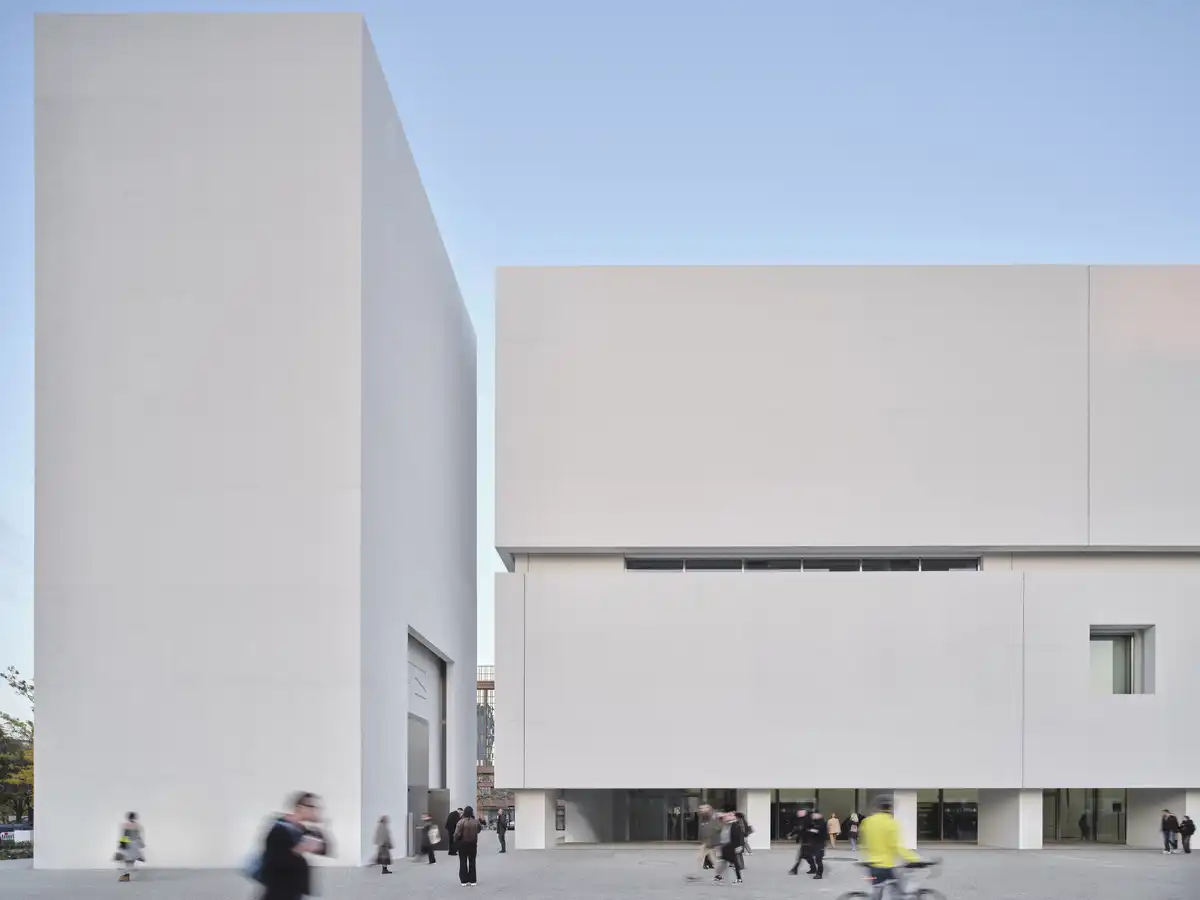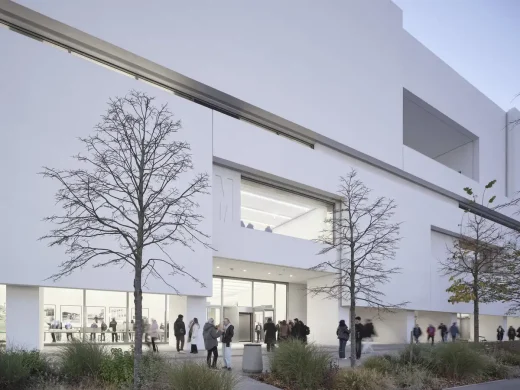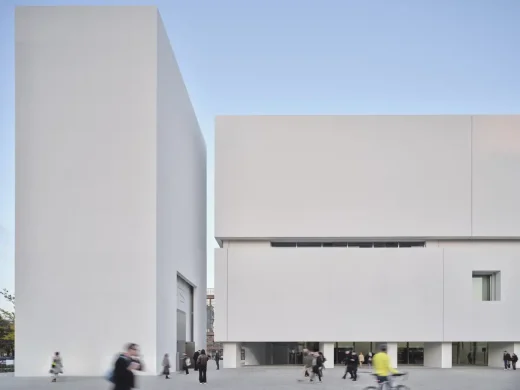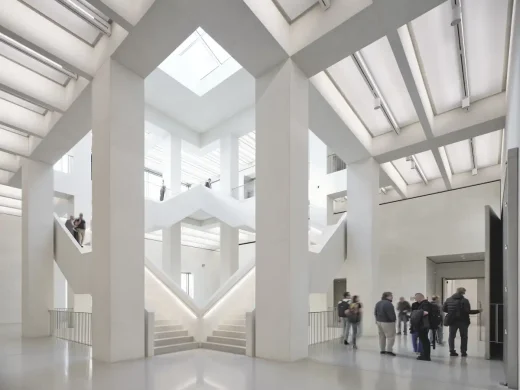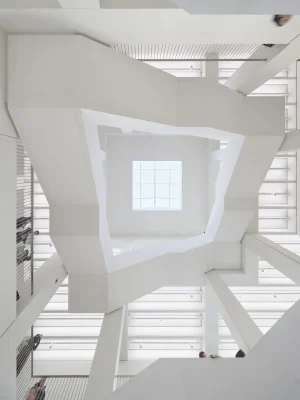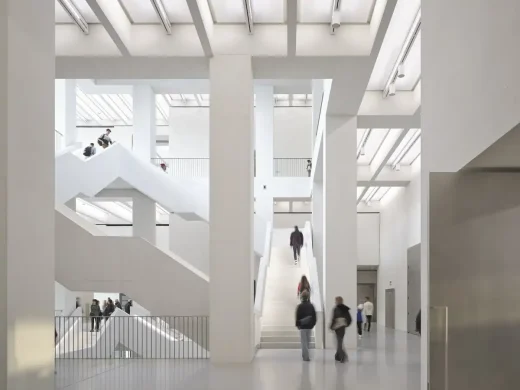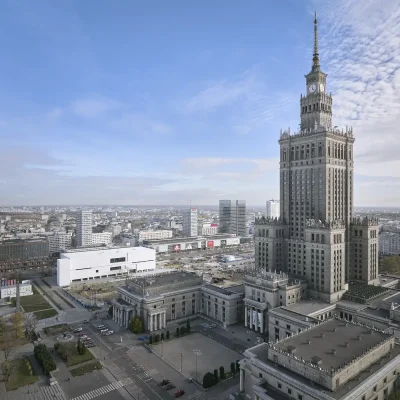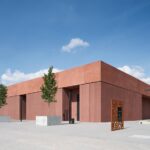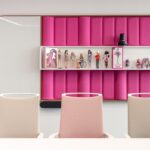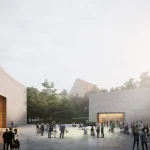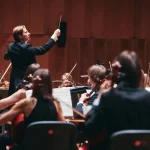Museum of Modern Art Warsaw building photos, Polish architecture design, Poland Arts
Museum of Modern Art in Warsaw
24 February 2025
Architecture: Thomas Phifer and Partners
Location: Plac Defilad, Warsaw, Poland
Photos by Marcin Czechowicz
Museum of Modern Art in Warsaw, Poland
The Museum of Modern Art in Warsaw (MSN Warsaw) today unveiled its inaugural exhibition in the Museum’s newly built home, designed by Thomas Phifer and Partners, in historic Plac Defilad (Parade Square).
The Impermanent: Four Takes on the Collection focuses on the ways artists from around the world have made sense of modernism and its political, economic, and artistic implications. Drawing from the Museum’s holdings of more than 4,300 artworks by Polish and international artists, the exhibition is a testimony to the changes that have taken place across the visual arts in the last seven decades. Thanks to the Museum’s strategic partnership with Audi, admission to the exhibition today will be free of charge.
The exhibition includes more than 150 works—half of which were created by women artists—from the 1950s to the present. More than 100 artists are represented in The Impermanent, the largest-ever exhibition presented by the Museum, which was founded in 2005.
Joanna Mytkowska, Director of MSN Warsaw, said, “When we set out to build MSN Warsaw’s first permanent home after the institution spent its first two decades as a roving museum, The Impermanent was precisely the kind of ambitious exhibition we wanted to be able to present. With a new building that matches the strength of our holdings, we now have a home that is perfectly suited to tell stories about the history of art that our collection can tell.”
The Exhibition
The Impermanent: Four Takes on the Collection is organized by a team of curators that includes Sebastian Cichocki, Tomasz Fudala, Magda Lipska, Szymon Maliborski, Łukasz Ronduda, and Natalia Sielewicz. Located on the second and third floors of the Museum, it is organized around four distinct themes, each providing a unique interpretation of developments in Post-War and contemporary art. The themes are:
“Banner: Engagement, Realism and Political Art,” presenting artworks directly engaged in political debate. Made by artists living in a variety of historical and political contexts, this section explores the ways art has been an integral part of wider debates concerning rights, policies, and power. Highlights include Alina Szapocznikow’s sculpture Friendship from 1954, which was partially destroyed when it was moved from the nearby Palace of Culture and Science in Warsaw in 1992. Also on view are works by Nikita Kadan, Gülsün Karamustafa, Lynette Yiadom-Boakye, Sharon Hayes, David Wojnarowicz, Prabhakar Pachpute, Włodzimierz Pawlak, William Pope.L, and Wilhelm Sasnal, among others.
“Synthetic Materialities: Body, Commodity and Fetish from the Cold War to the Present,” focusing on consumerism, pop culture, and mass media. This section looks at how art has expressed or clashed with capitalist values worldwide, focusing not only on artists from countries that had booming Post-War economies, but also those from some of the poorer countries of Eastern Europe and the Global South. This section features a work by Swiss artist Sylvie Fleury made of synthetic resin and fiberglass that depicts a slender woman in turquoise. Also included are artworks by Magdalena Abakanowicz, Isa Genzken, Soshiro Matsubara, Lucy McKenzie, Frances Stark, and others.
“Dark Planet: Art, Spirituality and Future Coexistence,” comprising works that come from non-traditional and isolated artistic practices, such as folk, amateur, and Indigenous art. Looking at the history of non-modernist traditions, these galleries focus on artists who attempted to “see through” the existing world into deeper, spiritual reality. Anchored by the work of post-Communist Polish artist Roman Stańczak, this part of the exhibition brings together artists from distant geographical and political contexts and reveals the possibility of a future community. Other artists included are Miriam Cahn, Trương Công Tùng, Nathalie Djurberg, Tau Lewis, Tala Madani, and Vivian Suter, among others.
“Real Abstractions: The Autonomy of Art Against the Catastrophes of Modernity,” presenting artworks that focus on the limits of art. Centered on the promises of modernism and the collapse of its utopian dream of unlimited progress, this section also looks at art’s relationship with other ways of understanding the world. Among the highlights is Monika Sosnowska’s Façade, a sculpture that depicts the collapse of a modern architectural building as a comment on the failures of modernism. Also on view are works by Kader Attia, Edi Hila, Arthur Jafa, Otobong Nkanga, Rebecca H. Quaytman, Ser Serpas, and more.
Natalia Sielewicz, Curator at MSN Warsaw, said, “This presentation stresses what we have always known to be true—that the art-historical canon is always changing and growing. The Impermanent: Four Takes on the Collection opens new pathways through the history of Post-War and contemporary art, unearthing lost narratives and linking artists and movements across wide geographical and historical ranges.”
The inaugural exhibition is accompanied by two new publications: a general-interest guide to MSN Warsaw’s collection, edited by Jagna Lewandowska, and a scholarly catalogue of the exhibition edited by Joanna Mytkowska and Katarzyna Szotkowska-Beylin.
“Banner: Engagement, Realism and Political Art” and “Synthetic Materialities: Body, Commodity and Fetish from the Cold War to the Present” are on view from February 21 to October 5, 2025. “Dark Planet: Art, Spirituality and Future Coexistence,” and “Real Abstractions: The Autonomy of Art Against the Catastrophes of Modernity” are on view from February 21 to August 31, 2025.
The Building
The Impermanent marks the complete opening of MSN Warsaw following a civic dedication for the building in October 2024, when the Museum began offering public programming on the ground floor. Framed by the Soviet-era Palace of Culture and Science on one side and an arcade of shops and malls on the other, the Museum anchors the revitalization of Parade Square, the largest public square in Europe and a gathering place for Varsovians since the 1950s.
The building includes 48,911 square feet of space for long-term and temporary exhibitions, a 150-seat theatre, state-of-the-art conservation studios, a performance auditorium, education spaces, and bookshop and café on the ground floor, which is always free and open to the public.
Thomas Phifer, founder of Thomas Phifer and Partners, said, “Our design for the Museum of Modern Art in Warsaw imagined the building as a vitrine of light. The galleries now serve as catalysts for Warsaw’s artistic voice, the remarkable cultural renaissance exemplified by this inaugural exhibition. The building is not only a museum but also a town hall where Varsovians can participate in the life and culture of their city.”
In contrast to the verticality of the Palace of Culture and Science, the MSN Warsaw building is organized horizontally and composed of two rectangular forms. Its distinguishing façade, composed of white, cast-in-place concrete hand-crafted by skilled local craftspeople, expresses the institution’s ethos and offers a lasting and timeless presence.
The façade is punctuated by the building’s horizontal ribbon of windows that filter clerestory light into the second-floor galleries. A continuous arcade serves as a transitional space between the city and the Museum, setting the stage for the experience within.
A monumental, classically inspired double-symmetrical staircase at the heart of the Museum is flooded with natural light, offering a space for social interaction. The openness of the ground floor creates a central meeting point and offers generous views of the city and through the Museum. The center space also organizes the entrances to the main suites of interconnected galleries on the two upper floors. Each suite of galleries on the two main exhibition levels features windowed “city rooms” lined in European ash that offer places for pause and reflection and framed views of the city of Warsaw.
Fixed galleries, ranging in height from 4 meters (13 ft) to 7.5 meters (25 feet), are each a different size and proportion. A system of louvres and scrims modulates natural light and activates the galleries throughout the day. The roof—referred to as the building’s “fifth facade”—offers continuous diffused daylight into the galleries. The galleries feature elegant but durable terrazzo floors.
The ground-level exterior is lined with newly planted honey locust trees that lightly enclose the forum.
About the Museum of Modern Art in Warsaw (MSN Warsaw)
Founded in 2005, the Museum of Modern Art in Warsaw (MSN Warsaw) is a public institution devoted to collecting, presenting, and interpreting international art made since 1989. With broad interests in the visual arts, graphic design, industrial design, architecture, performance, and multimedia art, the Museum holds more than 4,300 works acquired over the past two decades.
Included in the collection are works by Magdalena Abakanowicz, Alina Szapocznikow, Monika Sosnowska, Cecilia Vicuña, and Thomas Hirschhorn, among others. MSN Warsaw also collects objects of visual culture, including neon signs, posters, and post-internet art, and holds archives from important Polish Post-War art institutions such as the Foksal Gallery and the Experimental Studio of Polish Radio. It also retains more than 1,000 avant-garde films.
Thomas Phifer and Partners
Since founding Thomas Phifer and Partners in 1997, Thomas Phifer has completed the Museum of Modern Art in Warsaw, Poland, expansions of the Glenstone Museum in Potomac, Maryland, the Corning Museum of Glass in Corning, New York, and the North Carolina Museum of Art in Raleigh, North Carolina, as well as the United States Courthouse in Salt Lake City, Utah, the Brochstein Pavilion in Houston, Texas, and houses across the United States. Projects under construction include the TR Warszawa Theatre in Warsaw.
Thomas Phifer and Partners has received more than thirty honor awards from the American Institute of Architects. Mr. Phifer is the recipient of the Rome Prize in Architecture from the American Academy in Rome, the Medal of Honor and President’s Award from the New York Chapter of the AIA, the Arts and Letters Award in Architecture, and the National Design Award in Architectural Design from the Cooper Hewitt Smithsonian Design Museum. In 2022, he was elected as a lifetime member of the American Academy of Arts and Letters.
Architect: Thomas Phifer and Partners – https://www.thomasphifer.com/
Photography: Marcin Czechowicz
Museum of Modern Art, Warsaw, Poland images / information received 240225
Location: Plac Defilad, Warsaw, Poland, eastern Europe.
+++
New Polish Museum Building Designs
Contemporary Polish Museum Architecture
Polish History Museum in Warsaw Building – 2024 ULI Global Award for Excellence winner
Architects: WXCA
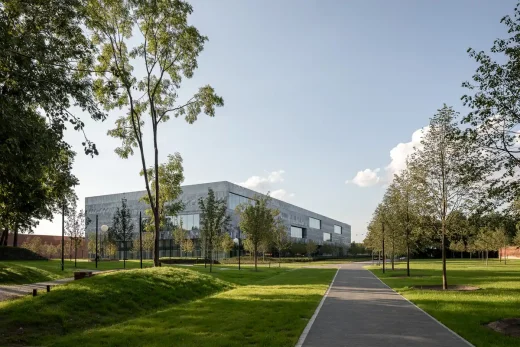
photo : WXCA_Daniel Ciesielski
Polish Army Museum Warsaw
Architecture: WXCA
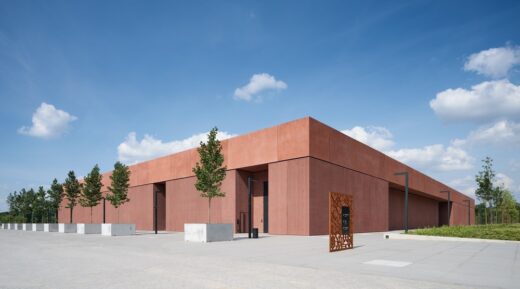
photo : Marcin Czechowicz
+++
New Polish Architecture
Contemporary Polish Architecture
Polish Architectural Designs – chronological list
Warsaw Architecture Tours by e-architect – Polish capital city walks for pre-booked groups
Varso Tower Warsaw, central Poland
Architecture: Foster + Partners
CPK Airport, between Warsaw and Łódź
Architecture: Foster + Partners, with Buro Happold
Villa Reden Apartments, Chorzów, Silesia, southern Poland
Design: Architekt Maciej Franta – Franta Group
Mausoleum of Martyrdom, Michniów, south-central Poland
Architects: Nizio Design International
Comments / photos for the Museum of Modern Art, Warsaw, Poland designed by Thomas Phifer and Partners architects in Plac Defilad page welcome.

